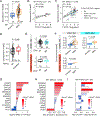High FOXA1 levels induce ER transcriptional reprogramming, a pro-metastatic secretome, and metastasis in endocrine-resistant breast cancer
- PMID: 37467106
- PMCID: PMC12369075
- DOI: 10.1016/j.celrep.2023.112821
High FOXA1 levels induce ER transcriptional reprogramming, a pro-metastatic secretome, and metastasis in endocrine-resistant breast cancer
Abstract
Aberrant activation of the forkhead protein FOXA1 is observed in advanced hormone-related cancers. However, the key mediators of high FOXA1 signaling remain elusive. We demonstrate that ectopic high FOXA1 (H-FOXA1) expression promotes estrogen receptor-positive (ER+) breast cancer (BC) metastasis in a xenograft mouse model. Mechanistically, H-FOXA1 reprograms ER-chromatin binding to elicit a core gene signature (CGS) enriched in ER+ endocrine-resistant (EndoR) cells. We identify Secretome14, a CGS subset encoding ER-dependent cancer secretory proteins, as a strong predictor for poor outcomes of ER+ BC. It is elevated in ER+ metastases vs. primary tumors, irrespective of ESR1 mutations. Genomic ER binding near Secretome14 genes is also increased in mutant ER-expressing or mitogen-treated ER+ BC cells and in ER+ metastatic vs. primary tumors, suggesting a convergent pathway including high growth factor receptor signaling in activating pro-metastatic secretome genes. Our findings uncover H-FOXA1-induced ER reprogramming that drives EndoR and metastasis partly via an H-FOXA1/ER-dependent secretome.
Keywords: CP: Cancer; breast cancer; cistrome; endocrine resistance; enhancer; epigenetic; estrogen receptor; forkhead box protein A1; metastasis; secretome; transcription factor.
Copyright © 2023 The Authors. Published by Elsevier Inc. All rights reserved.
Conflict of interest statement
Declaration of interests C.K.O. is a consultant/advisory board member for AstraZeneca, GlaxoSmithKline, Pfizer, Puma Biotechnologies, and Tolmar and on the Data Monitoring Committee for Eli Lilly. R.S. has received research support (to institute) from Puma Biotechnology, Gilead Sciences, and AstraZeneca; is a consultant/advisor of MacroGenics; holds patents, royalties, and other intellectual property from Wolters Kluwer/UpToDate; and has a patent pending (via institution; NRF Ref. BAYM.P0312US.P1-1001123973 “A multiparameter classifier to predict response to HER2-targeted therapy without chemotherapy in HER2-positive breast cancer”) with no revenue received. N.W. is a consultant/advisor for Eli Lilly and AstraZeneca, a member of the scientific advisory board and stockholder for Relay Therapeutics, and a member of the scientific advisory board and stockholder for Flare Therapeutics. He has previously received research support from Novartis and Puma Biotechnology, consulted with Novartis, and consulted with Foundation Medicine. R.J. has received research funding from Pfizer. M.F.R. has received research support from Pfizer and consults with Genentech, Novartis, Daiichi, AstraZeneca, Seagen, and MacroGenics. M.G. is a consultant/advisor for Eli Lilly, MSD, Novartis, Pfizer, Roche, and Seagen.
Figures







References
Grants and funding
LinkOut - more resources
Full Text Sources
Miscellaneous

